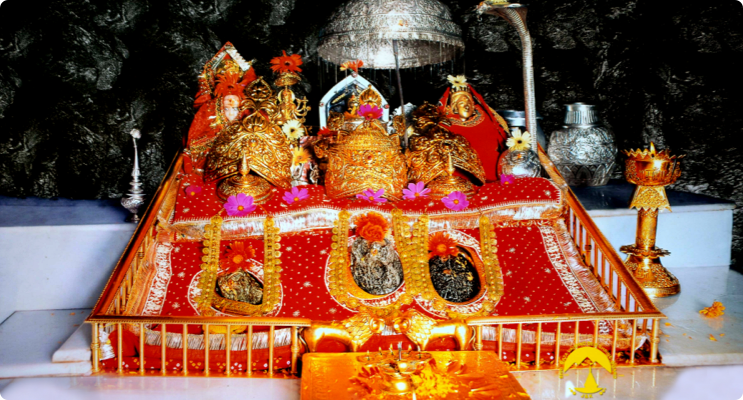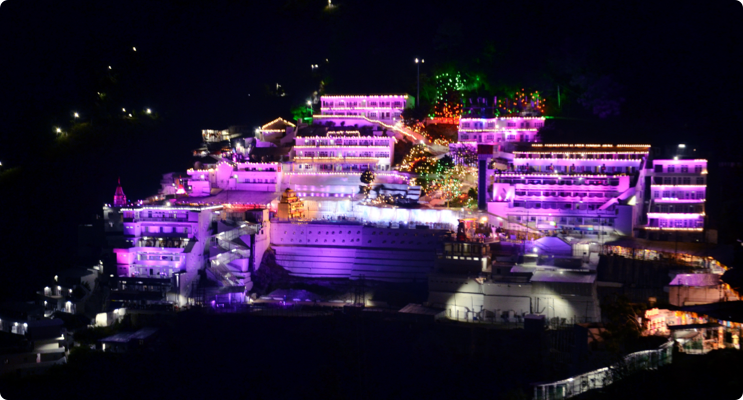
Unveiling the Spiritual Odyssey: A Journey to Mata Vaishno Devi
In the heart of India’s northern state of Jammu & Kashmir, nestled amidst the majestic Trikuta Mountains, lies a realm where spirituality and devotion merge seamlessly. Mata Vaishno Devi, a name that resonates with millions, beckons pilgrims from across the globe. Our voyage into this spiritual sanctuary is not merely a journey; it’s an awakening of the soul. We’ll unravel the enigma of Mata Vaishno Devi, explore the mythological tapestry that cloaks her, and traverse the arduous path pilgrims take to seek her divine blessings.
Mystical Origins: The Legend of Mata Vaishno Devi
At the core of this spiritual expedition is the enchanting legend of Mata Vaishno Devi. According to Hindu mythology, she is the embodiment formed by the spiritual strength of Goddess Maha Saraswati, Maha Lakshmi & Maha Kali in the form of Pindies, who sought refuge in the Trikuta Mountains to evade the relentless pursuit of the demon Bhairon Nath. For nine months, she meditated within a sacred cave, transforming into a divine, powerful entity to vanquish evil—a timeless tale of good triumphing over darkness.
The Pilgrimage of Devotion and Endurance
Venturing into the sanctified domain of Mata Vaishno Devi is not merely a religious voyage but a testament of one’s physical and mental mettle. From the base camp in Katra, pilgrims embark on a demanding trek spanning approximately 13 kilometers (8.1 miles). Many choose to traverse this path on foot, believing that it’s a journey of purification, a passage to spiritual fulfillment.
As you navigate the rugged terrain, you’ll encounter resting points and facilities for weary travelers. But it’s not just the trek; it’s a spiritual transformation—one step at a time.
A Tapestry of Devotion: Rituals and Offerings
At the heart of the pilgrimage is the Sanctum Sanctorum in cave shrine, where the deity reveals herself as a naturally formed three-headed stone image called Pindies representing Goddess Maha Saraswati, Maha Lakshmi & Maha Kali. Here, pilgrims offer their prayers, recite hymns, and perform sacred rituals. The atmosphere resonates with devotion, a chorus of seekers yearning for Mata Vaishno Devi’s blessings.
Devotees present offerings of flowers, fruits, and coconuts. The air is filled with the enchanting sounds of aarti, the rituals involving fire that light up the cave shrine. It’s a symphony of faith and spirituality that transcends words.
A Blessing Beyond Measure
For the faithful, Mata Vaishno Devi isn’t merely a religious obligation; it’s a deeply personal journey. Many believe that her divine presence fulfills their deepest desires, offering protection and guidance. It’s customary to tie a red thread around one’s wrist, symbolizing an unbreakable bond with the goddess.
Festivals and Celebrations: A Divine Spectacle
Vaishno Devi comes alive during festivals, most notably Navratri—a nine-day celebration dedicated to the goddess. The temple adorns itself with vibrant decorations, and special ceremonies draw even larger throngs of devotees.

Beyond the Temple: Nature’s Bounty
Amidst this spiritual tapestry lies the pristine beauty of the Trikuta Mountains. As you tread the path, you’ll witness breathtaking vistas, a testament to nature’s artistry. Nearby attractions, such as the Bhairon Temple and Ardh Kuwari, a cave entwined with Mata Vaishno Devi’s legend, beckon the curious traveler.
In summation, Vaishno Devi is more than a pilgrimage; it’s a convergence of spirituality, adventure, and a link to Hindu mythology and tradition. It’s a place where millions find solace, inspiration, and a profound connection to the divine.
Choosing the Perfect Time: When to Embark on this Spiritual Odyssey
The journey to Mata Vaishno Devi is deeply influenced by the seasons. Your choice of when to make this spiritual pilgrimage can significantly impact your experience. Here’s a breakdown of the best times to visit:
Spring (March to May)
– Spring is a favored time, offering pleasant weather and moderate temperatures.
– The lush, green landscape enhances the trek’s enjoyment, creating a picturesque backdrop.
– If you prefer milder weather and want to avoid extreme cold or heat, spring is ideal.
Summer (June to August)
– Summers can be warm during the day but cool during the nights.
– Expect larger crowds in June and July due to school vacations.
– This period suits those who can handle moderately warm temperatures and relish the scenic beauty.
Monsoon (July to September)
– Monsoons bring heavy rainfall, leading to slippery paths and landslides.
– Trekking during this season can be challenging and risky.
– It’s advisable to avoid this period unless you’re an experienced trekker prepared for the unpredictable.
Autumn (September to November)
– Autumn is among the best times to visit Vaishno Devi.
– The weather is pleasant with clear skies, ideal for both the pilgrimage and soaking in the natural beauty.
– Crowds are relatively smaller compared to summer.
Winter (December to February)
– Winters bring cold temperatures, especially at night, and the possibility of snowfall.
– The temple takes on a serene, less crowded atmosphere.
– This period suits those who can endure the cold and desire a more tranquil visit.
Ultimately, the best time depends on your weather and crowd preferences. Many opt for spring and autumn, striking a balance between pleasant weather and manageable crowds. Regardless of the season, always check the weather forecast, plan meticulously, and prepare for varying conditions at higher altitudes.
The Path to Divinity: How to Reach Mata Vaishno Devi
Reaching Mata Vaishno Devi entails a journey to the town of Katra, the gateway to this spiritual haven. Katra enjoys excellent connectivity to major Indian cities, and from there, the path to the temple unfolds:
By Air
– The nearest airport is Jammu Airport (Satwari Airport), well-connected to major Indian cities.
– Upon arrival at Jammu Airport, you can hire a taxi or take a bus to Katra, a journey of approximately 45 kilometers (28 miles), lasting 1.5 to 2 hours.
By Train
– The nearest major railway station is Jammu Tawi Railway Station, linked to cities across India.
– From Jammu Tawi, you can catch a train to Katra, the closest railhead to Vaishno Devi. It’s a short distance from the trek’s starting point.
By Road
– Katra enjoys robust road connectivity and can be reached by bus or private vehicle from cities like Jammu, Delhi, and Amritsar.
– Taxis and other transportation options are readily available for a direct road journey to Katra.
Trekking to Vaishno Devi
– Once reached in Katra, your pilgrimage commences. Most pilgrims opt for the 13-kilometer (8.1-mile) trek, although palanquins and ponies offer alternatives.
– The well-maintained path features rest areas, shops, and refreshment stalls to support your journey.
Helicopter Services
– For a swifter and more comfortable journey, consider helicopter services from Katra to Sanjichhat, closer to the temple.
– Advance booking is recommended which can be done online through the official website of shrine, and the helicopter ride offers panoramic views of the surrounding mountains.
Embarking on this spiritual odyssey to Mata Vaishno Devi is more than a physical journey; it’s a soul-stirring experience. Prepare yourself mentally, physically, and spiritually as you set foot on this sacred path—a path that promises not just a destination but a profound transformation of the heart and soul.
Jai Mata Di…!!